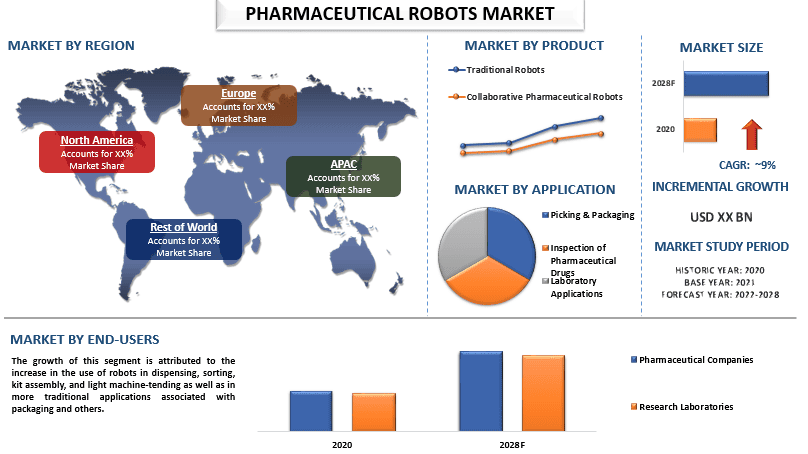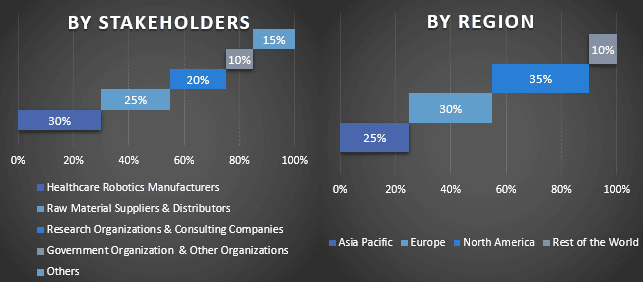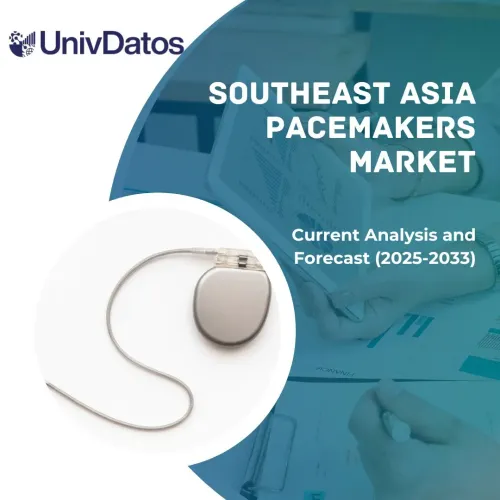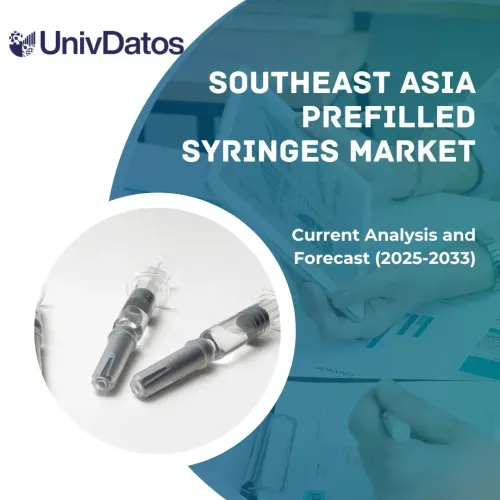- Home
- About Us
- Industry
- Services
- Reading
- Contact Us
Pharmaceutical Robots Market: Current Analysis and Forecast (2022-2028)
Emphasis on Product (Traditional Robots, and Collaborative Pharmaceutical Robots.); Application (Picking & Packaging, Inspection of Pharmaceutical Drugs, and Laboratory Applications); End-Users (Pharmaceutical Companies, and Research Laboratories); and Region/Country

The global pharmaceutical robots market is expected to grow at a significant rate of around 9% during the forecast period. The manufacturing of numerous drugs needs to be correct and green withinside the pharmaceutical sector. As a result, integrating robots withinside the production of prescription drugs will increase pleasantness at the same time as reducing charges and time. Moreover, inspection, packaging, laboratories, and the introduction of tailor-made drugs are all regions in which robots are beneficial. In addition, the sort of automation called a robot machine has numerous axes of movement and can be programmed to perform any task. With growing needs for precision, output, and faster turnaround times, automation, and robotics have won traction withinside the pharmaceutical industry.
Polaris Inc., Honda Motor Co. Ltd., Textron Inc., Kawasaki Heavy Industries Ltd., Yamaha Motor Co. Ltd., Suzuki Motor Corporation, Deere & Company, Bombardier Recreational Products Inc., KWANG YANG MOTOR CO., LTD., and Hisun Motors Corp. are some of the key players in the market. Several M&As along with partnerships have been undertaken by these players to facilitate customers with hi-tech and innovative products/technologies.
Insights Presented in the Report
“Amongst product, traditional robots to hold a significant share in the market in 2020”
Based on product, the market is categorized into traditional robots and collaborative pharmaceutical robots. Among these, traditional robots to hold a significant share in the market in 2020. Additionally, the growth of this segment is due to the increasing use of robots in traditional applications related to dispensing, sorting, kitting, light machine handling, and packaging, among others. Furthermore, the growth of this segment can be attributed to the rising adoption of various types of robotic systems and frequent product launches in the market. For example, in 2019, BIONIK Laboratories Corp. launched Next-Generation InMotion ARM/HAND Robotic System. This system was developed to assist patients with mobility impairments and to improve rehabilitation for stroke survivors.
“Amongst application, picking and packaging category is to witness a higher CAGR during the forecast period”
Based on application, the market is segmented into picking and packaging, inspection of pharmaceutical drugs, and laboratory applications. The picking and packaging category is to witness a higher CAGR during the forecast period with growing penetration from developing nations such as China, India, and Mexico, among others. The demand for custom packaging design and the benefits of using robots in pharmaceutical manufacturing are factors such as robot speed, accuracy, traceability, error-free operation, reduced risk of accidents, and efficient use of floor space, which are We contribute to the profitable growth of pharmaceutical companies.
“APAC to hold a significant share in the market”
For a better understanding of the market adoption of the pharmaceutical robots market industry, the market is analyzed based on its worldwide presence in the countries such as North America (U.S., Canada, Rest of North America), Europe (Germany, U.K., France, Spain, Italy, Rest of Europe), Asia-Pacific (China, Japan, India, Rest of Asia-Pacific), Rest of World. APAC held a significant share of the global pharmaceutical robot market. This is mainly due to increasing activity penetration fueled by increasing disposable income and increasing per capita spending of individuals in emerging markets in the region driving the market growth. The presence of many local pharmaceutical companies in countries such as Japan and China are driving the industrial robot market in the Asia-Pacific region. The presence of large pharmaceutical companies with large manufacturing facilities in these countries should boost growth in the region.
Reasons to buy this report:
- The study includes market sizing and forecasting analysis validated by authenticated key industry experts.
- The report presents a quick review of overall industry performance at one glance.
- The report covers an in-depth analysis of prominent industry peers with a primary focus on key business financials, product portfolio, expansion strategies, and recent developments.
- Detailed examination of drivers, restraints, key trends, and opportunities prevailing in the industry.
- The study comprehensively covers the market across different segments.
- Deep dive regional level analysis of the industry.
Customization Options:
The global pharmaceutical robots market can further be customized as per the requirement or any other market segment. Besides this, UMI understands that you may have your own business needs, hence feel free to connect with us to get a report that completely suits your requirements.
Table of Content
Research Methodology for the Pharmaceutical Robots Market Analysis (2022-2028)
Analyzing the historical market, estimating the current market, and forecasting the future market of the global pharmaceutical robots market were the three major steps undertaken to create and analyze the adoption of pharmaceutical Robots markets in major regions globally. Exhaustive secondary research was conducted to collect the historical market numbers and estimate the current market size. Secondly, to validate these insights, numerous findings and assumptions were taken into consideration. Moreover, exhaustive primary interviews were also conducted, with industry experts across the value chain of the global pharmaceutical robots Market. Post assumption and validation of market numbers through primary interviews, we employed a top-down/bottom-up approach to forecasting the complete market size. Thereafter, market breakdown and data triangulation methods were adopted to estimate and analyze the market size of segments and sub-segments of the industry pertains to. Detailed methodology is explained below:
Analysis of Historical Market Size
Step 1: In-Depth Study of Secondary Sources:
Detail secondary study was conducted to obtain the historical market size of the pharmaceutical robots market through company internal sources such as annual reports & financial statements, performance presentations, press releases, etc., and external sources including journals, news & articles, government publications, competitor publications, sector reports, third-party database, and other credible publications.
Step 2: Market Segmentation:
After obtaining the historical market size of the pharmaceutical robots market, we conducted a detailed secondary analysis to gather historical market insights and share for different segments & sub-segments for major regions. Major segments are included in the report as product, application, and end-user. Further country-level analyses were conducted to evaluate the overall adoption of testing models in that region.
Step 3: Factor Analysis:
After acquiring the historical market size of different segments and sub-segments, we conducted a detailed factor analysis to estimate the current market size of the pharmaceutical robots market. Further, we conducted factor analysis using dependent and independent variables such as various applic product, application, and end-user of pharmaceutical robot markets. A thorough analysis was conducted for demand and supply-side scenarios considering top partnerships, mergers and acquisitions, business expansion, and product launches in the pharmaceutical robots market sector across the globe.
Current Market Size Estimate & Forecast
Current Market Sizing: Based on actionable insights from the above 3 steps, we arrived at the current market size, key players in the global pharmaceutical robots market, and market shares of the segments. All the required percentage shares split, and market breakdowns were determined using the above-mentioned secondary approach and were verified through primary interviews.
Estimation & Forecasting: For market estimation and forecast, weights were assigned to different factors including drivers & trends, restraints, and opportunities available for the stakeholders. After analyzing these factors, relevant forecasting techniques i.e., the top-down/bottom-up approach were applied to arrive at the market forecast for 2028 for different segments and sub-segments across the major markets globally. The research methodology adopted to estimate the market size encompasses:
- The industry’s market size, in terms of revenue (USD) and the adoption rate of the pharmaceutical robots market across the major markets domestically
- All percentage shares, splits, and breakdowns of market segments and sub-segments
- Key players in the global pharmaceutical robots market in terms of products offered. Also, the growth strategies adopted by these players to compete in the fast-growing market
Market Size and Share Validation
Primary Research: In-depth interviews were conducted with the Key Opinion Leaders (KOLs) including Top Level Executives (CXO/VPs, Sales Head, Marketing Head, Operational Head, Regional Head, Country Head, etc.) across major regions. Primary research findings were then summarized, and statistical analysis was performed to prove the stated hypothesis. Inputs from primary research were consolidated with secondary findings, hence turning information into actionable insights.
Split of Primary Participants in Different Regions

Market Engineering
The data triangulation technique was employed to complete the overall market estimation and to arrive at precise statistical numbers for each segment and sub-segment of the global pharmaceutical robots market. Data was split into several segments & sub-segments post studying various parameters and trends in the areas of product, application, and end-user in the global pharmaceutical robots market.
The main objective of the Global Pharmaceutical Robots Market Study
The current & future market trends of the global pharmaceutical robots market were pinpointed in the study. Investors can gain strategic insights to base their discretion for investments on the qualitative and quantitative analysis performed in the study. Current and future market trends determined the overall attractiveness of the market at a regional level, providing a platform for the industrial participant to exploit the untapped market to benefit from a first-mover advantage. Other quantitative goals of the studies include:
- Analyze the current and forecast market size of the pharmaceutical robots market in terms of value (USD). Also, analyze the current and forecast market size of different segments and sub-segments
- Segments in the study include areas of product, application, and end-user.
- Define and analysis of the regulatory framework for the pharmaceutical robots market
- Analyze the value chain involved with the presence of various intermediaries, along with analyzing customer and competitor behaviors of the industry.
- Analyze the current and forecast market size of the pharmaceutical robots market for the major region.
- Major countries of regions studied in the report include Asia Pacific, Europe, North America, and the Rest of the World.
- Company profiles of the pharmaceutical robots market and the growth strategies adopted by the market players to sustain in the fast-growing market
- Deep dive regional level analysis of the industry
Related Reports
Customers who bought this item also bought










